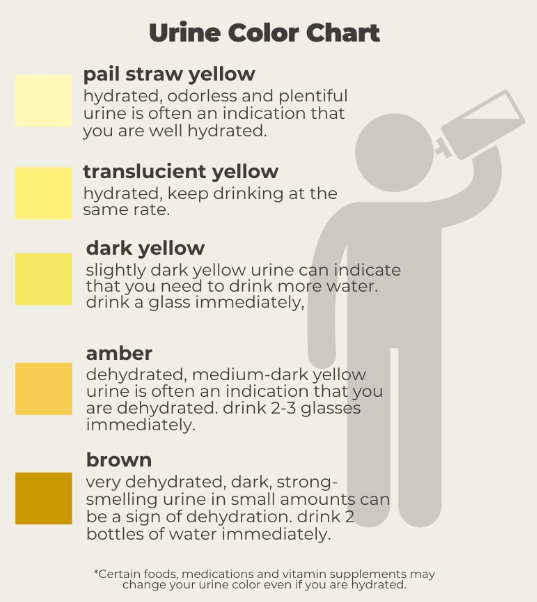BOURSESSENEGAL – When it comes to your health, one of the simplest indicators is the color of your urine. The urine color chart serves as a useful tool to help you understand what your body might be telling you. By examining your urine’s hue, you can gain insights into your hydration levels, diet, and even potential health issues. In this blog post, we’ll delve into the details of the urine color chart, its significance, and how you can use it to monitor your well-being.
What is the Urine Color Chart?
An Overview of the Urine Color Spectrum
The urine color chart is a visual reference that categorizes urine into various colors, from pale yellow to dark amber. Each shade represents a different level of hydration and can indicate how well your kidneys are functioning.
- Pale Yellow: This typically indicates good hydration. Your body is well-hydrated, which means your kidneys are effectively filtering waste.
- Dark Yellow: This color suggests you may need to drink more water. Your body might be slightly dehydrated.
- Amber or Honey: This indicates moderate dehydration. It’s a clear sign that you should increase your fluid intake.
- Brown: Dark brown urine can be a warning sign. It might indicate severe dehydration or liver issues.
- Red or Pink: This can result from eating certain foods, like beets, but it can also signal blood in the urine, which requires medical attention.
The Importance of Hydration
Maintaining proper hydration is crucial for overall health. The urine color chart helps you gauge your hydration levels easily. A well-hydrated body flushes out toxins more efficiently, aiding in various bodily functions, including digestion and metabolism.
How to Use the Urine Color Chart
Step-by-Step Guide to Monitoring Your Urine Color
To use the urine color chart effectively, follow these steps:
- Collect a Sample: When you urinate, collect a small sample in a clear container. This allows you to observe the color accurately.
- Compare the Color: Hold the sample next to the urine color chart. Take note of the shade and find the closest match.
- Evaluate Your Hydration: Based on the color, determine your hydration status. If you notice dark yellow or amber, it’s time to drink more fluids.
- Track Changes: Monitor your urine color over time. This can help you understand how your hydration levels fluctuate with changes in your diet or activity levels.
Factors That Affect Urine Color
Diet and Nutrition
Your diet plays a significant role in the color of your urine. Foods like asparagus can lead to a distinct odor, while beets may give urine a reddish tint. Staying aware of these dietary influences helps in interpreting your urine color accurately.
Medications and Supplements
Certain medications and supplements can also alter urine color. For instance, some antibiotics can turn urine bright yellow. Be sure to consider any recent changes in your medication when assessing your urine.
Health Conditions
While the urine color chart is a helpful tool, it’s important to recognize that certain medical conditions can affect urine color. Conditions like urinary tract infections or liver diseases can lead to unusual colors. If you notice persistent changes, consult a healthcare professional.
Common Misconceptions About Urine Color
Debunking Myths Surrounding Urine Color
There are several myths surrounding the interpretation of urine color. Let’s address a few common misconceptions:
- Myth: Dark urine always means dehydration.
Reality: While dark urine often indicates dehydration, it can also result from certain foods or medications. - Myth: Clear urine means you’re overhydrated.
Reality: Clear urine can indicate proper hydration, but excessively clear urine might suggest overhydration, which can also have health implications.
When to Seek Medical Advice
If you observe persistent or extreme changes in your urine color, it’s crucial to seek medical advice. Signs to watch for include:
- Red or Pink Urine: This may indicate blood and requires immediate evaluation.
- Dark Brown Urine: This can signal liver issues or severe dehydration.
- Foul Smell: A strong odor may indicate an infection.
Tips for Maintaining Optimal Hydration
Simple Strategies to Stay Hydrated
- Drink Water Regularly: Aim for at least 8 glasses a day. Increase this amount based on your activity level or climate.
- Monitor Your Urine Color: Use the urine color chart as a daily check-in. This simple step can guide your hydration habits.
- Incorporate Hydrating Foods: Foods like cucumbers, oranges, and watermelons have high water content and contribute to overall hydration.
- Limit Diuretics: Be mindful of caffeine and alcohol, as they can increase urine output and lead to dehydration.
Conclusion: Stay Informed and Proactive
The urine color chart is a practical and accessible tool that can provide valuable insights into your health. By regularly monitoring your urine color, you empower yourself to take control of your hydration and overall well-being. Remember, while the color of your urine can offer clues, it should not replace professional medical advice. If you have concerns about your health, always consult with a healthcare provider.
By staying informed and proactive, you can use this simple guide to enhance your understanding of your body and make informed choices about your health. Keep your urine color chart handy, and make hydration a priority in your daily routine. Your body will thank you for it
REFERENCE : https://www.health.com/



